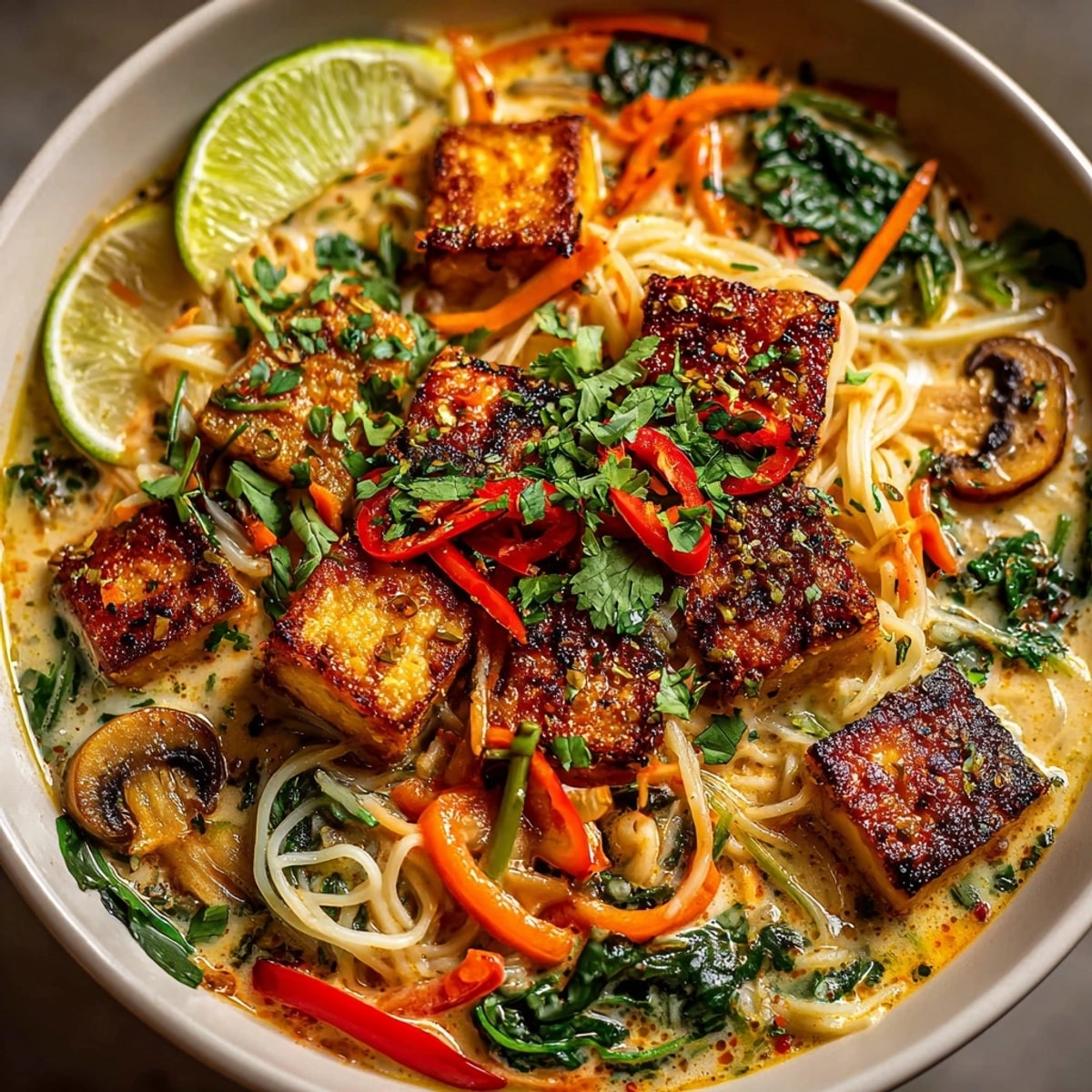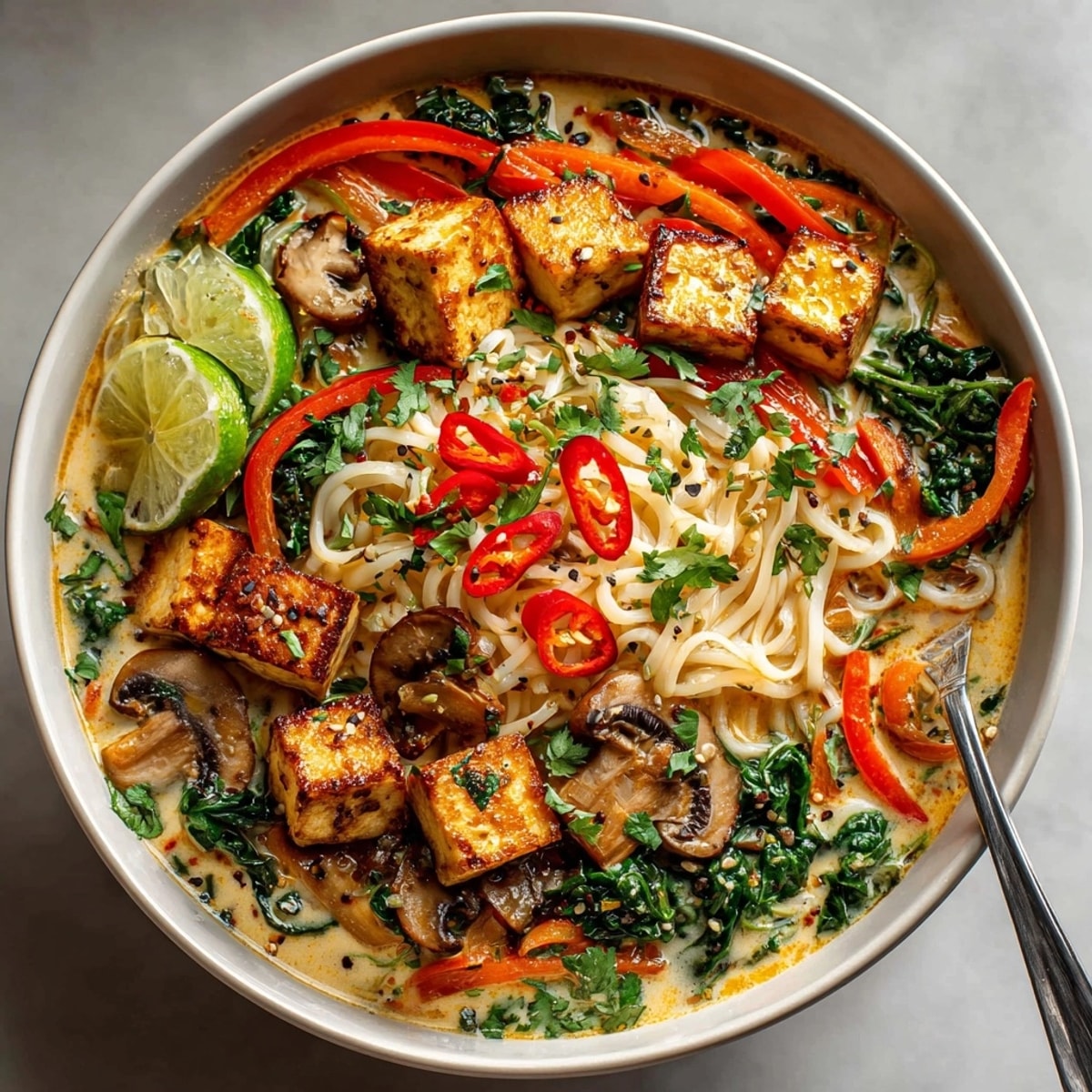 Save
Save This fragrant one-pot Thai coconut curry noodle soup has become my go-to comfort meal whenever I crave bold flavors without spending hours in the kitchen. The creamy coconut broth infused with aromatic curry paste creates a perfect balance of spicy, sweet, and tangy notes that wrap around tender noodles and vibrant vegetables.
I first created this recipe during a particularly rainy weekend when I was craving something warming yet vibrant. After experimenting with different curry pastes and noodle varieties, this version became an instant favorite that my family now requests at least twice a month.
Ingredients
- Coconut oil: creates the perfect foundation for blooming the curry paste and adds a subtle richness
- Thai red curry paste: the heart of this dish providing authentic flavor without needing dozens of individual spices
- Fresh ginger and garlic: essential aromatics that create the fragrant base
- Coconut milk: use full fat for the creamiest texture and most luxurious mouthfeel
- Rice noodles: absorb the flavorful broth beautifully while keeping the dish gluten free if needed
- Tofu: adds protein while soaking up the curry flavors like a sponge
- Colorful vegetables: bell peppers carrots spinach and mushrooms add nutrition texture and visual appeal
- Lime juice: brightens the entire dish and balances the richness of the coconut milk
- Brown sugar: just enough to round out the flavors without making the soup too sweet
Instructions
- Sauté the Aromatics:
- Heat coconut oil in a large pot over medium heat until shimmering but not smoking. Add your thinly sliced onion and cook for a full 3 minutes stirring occasionally until they become translucent and slightly soft. This creates the flavor foundation for your soup.
- Bloom the Spices:
- Add minced garlic and grated ginger to the pot stirring constantly for exactly 60 seconds until intensely fragrant but not browned. Then incorporate the Thai red curry paste using a wooden spoon to coat the aromatics thoroughly allowing the paste to toast slightly for another minute. This process wakes up the essential oils in the spices dramatically enhancing their flavor.
- Add Vegetables and Protein:
- Introduce your bell pepper slices carrots mushrooms and tofu or chicken if using to the fragrant base. Sauté for 3 to 4 minutes tossing frequently until the vegetables begin to soften slightly but still maintain their structure. The vegetables will continue cooking in the broth so we want them slightly underdone at this stage.
- Create the Broth:
- Pour in the full can of coconut milk first stirring to incorporate any curry paste that might be sticking to the bottom of the pot then add the vegetable broth. Bring the mixture to a gentle boil watching carefully as coconut milk can boil over quickly then immediately reduce to a simmer. Allow everything to cook together for 10 minutes so the flavors can meld and the vegetables can become tender.
- Cook the Noodles:
- Add your rice noodles directly to the simmering broth stirring gently to separate the strands. Cook according to the package instructions typically 4 to 6 minutes until just tender. Stir occasionally to prevent clumping as the noodles will release starch that can cause them to stick together.
- Finish with Seasonings:
- Stir in soy sauce brown sugar and fresh lime juice creating the perfect balance of salty sweet and sour. Add the baby spinach last letting it wilt for just 1 to 2 minutes. Taste the broth and adjust seasonings adding more lime juice soy sauce or curry paste if needed for your perfect balance of flavors.
 Save
Save The curry paste is truly the secret weapon in this recipe. I always keep several varieties in my pantry for quick meals. Red curry paste tends to be the most versatile with a balance of heat and flavor that appeals to most palates, but feel free to experiment with green or yellow curry pastes for different flavor profiles.
Storage and Make-Ahead Tips
This soup makes excellent leftovers, though I recommend storing any unused portions with the noodles separate from the broth if possible. Rice noodles tend to absorb liquid like sponges, so they'll become very soft if left in the broth overnight. If you've already combined everything, don't worry—the flavors will still be delicious, and you might just need to add a splash of broth when reheating.
For meal prep, you can prepare the soup through step 4, stopping before adding the noodles. Cool the broth with vegetables and protein, then refrigerate for up to 3 days. When ready to serve, reheat the broth to a simmer, add fresh noodles, and finish with the seasonings and spinach.
Ingredient Substitutions
This recipe welcomes adaptations based on what you have available. For protein, swap the tofu for chicken, shrimp, or even thinly sliced beef. Vegetable-wise, broccoli, snow peas, and bok choy all work beautifully in place of or in addition to the vegetables listed.
No rice noodles? Ramen, udon, or even angel hair pasta can work in a pinch. Just adjust cooking times accordingly as these alternatives may cook faster or slower than rice noodles.
If coconut milk isn't your preference, you can substitute with cashew cream for a different but equally creamy texture. Those avoiding soy can replace soy sauce with coconut aminos, which provide a similar umami quality with slightly sweeter notes.
Serving Suggestions
For a complete Thai-inspired meal, serve smaller portions of this soup alongside fresh spring rolls with peanut dipping sauce. The contrast between the hot soup and cool, crisp rolls creates a delightful textural experience.
Set up a garnish bar with extra lime wedges, bean sprouts, sliced chilies, crushed peanuts, and fresh herbs like Thai basil, mint, and cilantro. This interactive approach allows everyone to customize their bowl to their preferred level of heat and freshness.
For beverages, nothing complements this soup better than a cold Thai iced tea or a light lager beer that won't overwhelm the complex flavors of the curry.
 Save
Save The true beauty of this one-pot wonder lies in its adaptability and forgiving nature. Even on nights when I'm too tired to follow a recipe precisely, throwing together these basic components still results in a satisfying meal that feels like a warm hug in a bowl.
Recipe FAQ
- → Can this dish be made vegan or gluten-free?
Yes! Use vegetable broth and tofu for a vegan option, and gluten-free noodles along with tamari for a gluten-free meal.
- → What type of noodles work best?
Medium or thin rice noodles are ideal for a silky texture, but wheat noodles can be used if gluten is not a concern.
- → How spicy is the soup?
The heat mainly comes from red curry paste and fresh chili; increase or reduce both according to your taste.
- → What protein options complement the soup?
Firm tofu, chicken breast, shrimp, or shredded rotisserie chicken all work well and can be added for protein variety.
- → What garnishes add the best finishing touch?
Fresh cilantro, lime wedges, and sliced red chili provide brightness and color. Adjust based on personal preference.
- → Can the soup be made ahead?
It’s best enjoyed fresh, but you can prep the components ahead and combine just before serving to maintain noodle texture.